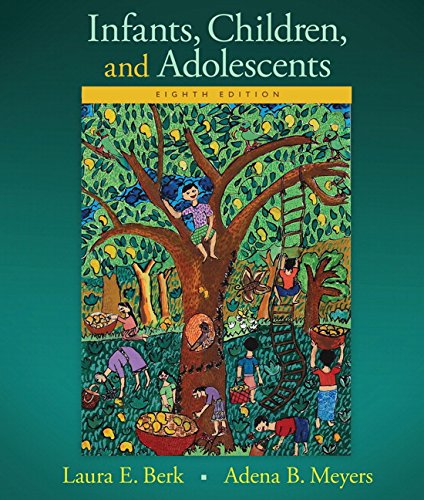Infants Children And Adolescents 8th Edition By Berk Meyers -Test Bank
Digital item No Waiting Time Instant DownloadISBN-10: 0133936732 ISBN-13: 978-0133936735Publisher : Pearson; 8th editionAuthors: Laura Berk, Adena Meyers
In Stock
Original price was: $55.00.$35.00Current price is: $35.00.
Infants Children And Adolescents 8th Edition By Berk Meyers -Test Bank
Table of Contents
Test Bank for Infants, Children, and Adolescents, 8th Edition by Laura E. Berk and Adena B. Meyers
The “Test Bank for Infants, Children, and Adolescents, 8th Edition” by Laura E. Berk and Adena B. Meyers is an essential educational resource designed to support educators and students in mastering the principles and applications of child development. This comprehensive test bank complements the textbook by offering a diverse array of questions that assess and reinforce understanding of key concepts and practical skills, making it an invaluable tool for both teaching and learning. Below is a detailed overview of the components and benefits of this test bank:
Overview of Test Bank Content
- Chapter-by-Chapter Organization
- The test bank is meticulously organized to align with each chapter of the textbook, ensuring comprehensive coverage of all critical topics. This structure facilitates easy integration into the curriculum and enables targeted assessments.
- Types of Questions
- Multiple-Choice Questions (MCQs): These questions cover a broad spectrum of knowledge, from basic recall to complex application and critical thinking. Each question includes well-crafted distractors to challenge students’ understanding.
- True/False Questions: These questions evaluate students’ ability to distinguish between correct and incorrect statements, reinforcing factual knowledge and addressing common misconceptions.
- Fill-in-the-Blank Questions: These questions focus on recalling specific details such as key terms, developmental stages, and important concepts, testing students’ memory and understanding.
- Short Answer Questions: These questions require detailed yet concise responses, assessing students’ ability to explain developmental psychology concepts clearly and accurately.
- Essay Questions: These questions evaluate students’ ability to synthesize and articulate complex ideas, demonstrating a deep understanding of child development principles and their applications.
- Case Studies and Scenarios: Real-world scenarios and case studies help students apply theoretical knowledge to practical situations, enhancing their critical thinking and problem-solving skills.
- Difficulty Levels
- Questions are categorized by difficulty to provide a range of challenges and assess students’ proficiency at different levels, including:
- Basic: Testing foundational knowledge and comprehension.
- Intermediate: Requiring application of knowledge to practical child development scenarios.
- Advanced: Involving critical thinking, analysis, and synthesis of complex developmental information.
- Questions are categorized by difficulty to provide a range of challenges and assess students’ proficiency at different levels, including:
- Core Focus Areas
- Introduction to Child Development: Questions covering the basic principles and scope of child development, including historical perspectives and research methods.
- Biological and Environmental Foundations: Detailed coverage of genetic and environmental influences on development, including prenatal development and birth.
- Physical Development: Assessing knowledge of physical growth, motor skills development, and health during infancy, childhood, and adolescence.
- Cognitive Development: Focus on cognitive theories and processes, including Piaget’s stages of development, information processing, and language development.
- Emotional and Social Development: Examining emotional regulation, attachment, identity formation, and social relationships throughout development.
- Family and Peer Relationships: Questions on the role of family dynamics, parenting styles, and peer interactions in child development.
- Cultural Influences: Coverage of cultural and societal impacts on development, including the role of media, education, and socioeconomic status.
- Developmental Challenges and Disorders: Assessing understanding of developmental disorders, including autism, ADHD, and learning disabilities, along with intervention strategies.
- Educational Implications: Questions on the application of developmental principles in educational settings, including teaching strategies and curriculum design.
- Research and Evidence-Based Practice: Focus on research methodologies, interpreting developmental studies, and applying research findings to practice.
- Alignment with Learning Objectives
- Each question in the test bank is aligned with the learning objectives outlined in the textbook, ensuring that assessments are relevant and targeted toward achieving the intended educational outcomes. This alignment helps in accurately measuring students’ progress and comprehension.
- Educational Support and Utility
- For educators, the test bank provides a comprehensive resource for creating quizzes, exams, and other assessments. It simplifies the process of test creation and ensures consistency and alignment with the curriculum.
- For students, the test bank serves as a valuable tool for self-assessment and study, helping them identify areas of strength and weakness and focus their efforts on areas needing improvement.
Benefits of Using the Test Bank
- Enhanced Learning and Retention
- The diverse range of question types and difficulty levels helps reinforce learning through varied and repeated exposure to key concepts, enhancing retention and understanding.
- Preparation for Real-World Applications
- By focusing on real-world scenarios and practical applications, the test bank prepares students for the practical aspects of child development, ensuring they are ready to apply their knowledge in various settings, including clinical, educational, and research environments.
- Comprehensive Assessment
- The test bank allows for thorough and multi-faceted evaluation of students’ knowledge and skills, from basic understanding to advanced application, ensuring a well-rounded educational experience.
- Efficient Teaching Resource
- For educators, the test bank simplifies the process of creating assessments, providing a consistent and reliable tool for evaluating students’ progress and readiness for advanced studies in child development.
Conclusion
The “Test Bank for Infants, Children, and Adolescents, 8th Edition” by Laura E. Berk and Adena B. Meyers is an essential resource for child development education. It provides structured, comprehensive, and versatile tools for assessing and enhancing students’ knowledge and skills in child development. By aligning closely with the textbook and emphasizing real-world application, the test bank supports the development of competent, confident professionals ready to excel in their understanding and application of child development principles in various settings.


Reviews
There are no reviews yet.